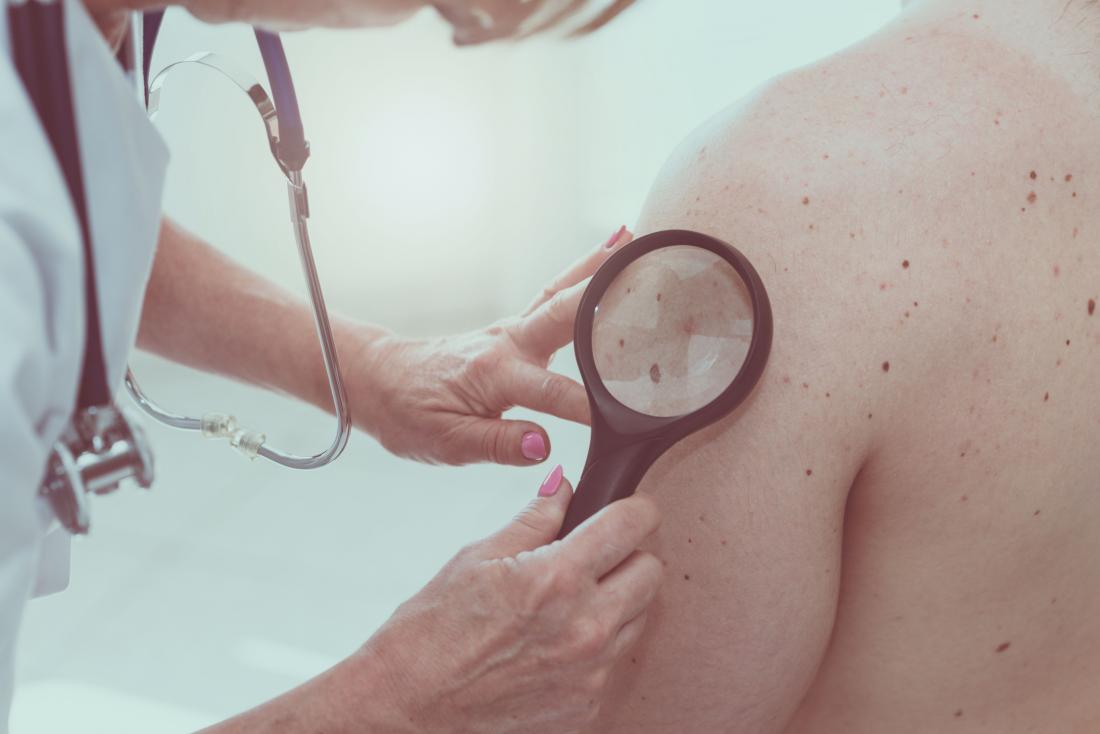According to the Centers for Disease Control and Prevention (CDC), cancer was the second leading cause of death in the United States in 2016.
Healthcare providers can run diagnostic tests that identify early-stage cancers. Treatment has a better chance of success when a person receives their cancer diagnosis early.
In this article, we discuss general warning signs of cancer unique to women, men, and cancer type.
Warning signs of cancer in women
Cancers specific to or more common among women include endometrial, cervical, and breast cancers. Warning signs include:
Breast changes

Breast cancer can cause visible changes in the breast tissue.
Breast cancer often causes visible changes in the breast tissue, so it is crucial for women to be familiar with the shape, size, and texture of their breasts.
Breast changes to look out for include:
- dimpling or puckering of the breast skin or nipple
- nipple discharge
- redness, swelling, or tenderness of the breast skin or nipple
- changes in the size or shape of the breast
Women should speak with a healthcare provider if they notice any changes in their breast tissue. The American Cancer Society recommend that women aged 40 years and older have regular mammograms to screen for signs of breast cancer.
Vaginal bleeding between periods
Women who experience regular periods may want to consult their healthcare provider if they experience vaginal bleeding or spotting outside of their usual cycle. Irregular vaginal bleeding may indicate endometrial or cervical cancers.
Women who have gone through menopause should seek immediate medical attention if they have any vaginal bleeding.
Spotting does not always occur as a result of cancer. Hormonal birth control, chronic medical conditions, and stress can also cause spotting.
Women should consider seeking immediate medical attention if they experience spotting alongside the following symptoms:
Warning signs of cancer in men
Certain warning signs of cancer occur exclusively or more frequently in men than women. These can include:
Testicular lumps
Although testicular cancer in men is rare, rates of new diagnoses continue increasing around the world. The American Cancer Society estimates roughly 9,560 people in the U.S. will receive a testicular cancer diagnosis in 2019.
A hard, painless lump in the testicle is a symptom of testicular cancer. Other symptoms of testicular cancer include:
- swelling or pain in a testicle or scrotum
- a feeling of heaviness in the scrotum
- pain in the groin
- a dull ache in the lower back or abdomen
Bowel changes
A persistent change in bowel habits can indicate cancers of the colon or rectum, which people collectively refer to as colorectal cancers.
Colorectal cancer can cause frequent diarrhea or constipation and persistent abdominal pain. Other symptoms include:
- thin stools
- unintentional weight loss
- fatigue
- anemia
- excess gas or bloating
Rectal bleeding
Colorectal cancers can cause bleeding in the digestive tract. Stools may contain visible blood or appear darker than usual.
Having rectal bleeding or bloody stools does not necessarily mean a person has cancer. Hemorrhoids, ulcers, and other gastrointestinal disorders can all cause bleeding.
However, men should not ignore this symptom and should see a doctor immediately, as it may signify a serious medical problem.
Urinary changes
Changes in urinary habits is a symptom of both prostate and bladder cancers.
Both forms of cancer can impact the urinary tract and cause the following symptoms:
- difficulty initiating urination
- difficulty emptying the bladder
- frequently feeling the need to empty the bladder
- incontinence or involuntary urination
- blood in the urine
Prostate and bladder cancers are among the most common types of cancer among men in the U.S.
The following sections look at the warning signs specific to different cancers.
Skin cancer

A mole that changes color or size may be a sign of melanoma.
Skin cancer is the most common type of cancer in the U.S.
There are two types of skin cancers — nonmelanoma and melanoma. According to the National Cancer Institute, 1,195,608 people in the U.S. were living with skin melanoma in 2016.
Skin cancer can develop on any part of the skin, but it often appears in areas that have had exposure to the sun, such as the face, neck, arms, and hands.
The main types of skin cancer include basal cell carcinoma, squamous cell carcinoma, and melanoma. Although less common, melanoma is generally more dangerous than nonmelanoma skin cancers.
A basal cell carcinoma typically looks like a shiny, yellow lump or a bleeding sore that heals and reopens.
A squamous cell carcinoma can appear as either a firm, red bump or a flat, scaly lesion.
Melanoma can develop on regular skin or inside an existing mole. Signs of melanoma include:
- a mole that changes in color or size
- an irregularly shaped lesion that appears red, pink, white, dark blue
- a large brown spot with darker colored speckles
Breast cancer
Breast cancer is the most common form of cancer and the second leading cause of cancer death among women, according to the National Breast Cancer Foundation.
According to the American Cancer Society, women in the U.S have about a 12% chance of developing breast cancer in their lifetime.
Besides the appearance of a painless lump in the breast tissue, warning signs of breast cancer include:
- changes to the texture of the skin, such as dimpling or scaling
- unusual nipple discharge
- redness, swelling, or pain in the breast or nipple
Lung cancer
Lung cancer does not always produce noticeable symptoms in the early stages. If symptoms do appear, people can mistake them for acute respiratory infections or a cold.
Warning signs of lung cancer include:
- a persistent cough that can worsen over time
- frequent respiratory infections, such as pneumonia or bronchitis
- hoarseness or other changes to a person’s voice
- shortness of breath or wheezing
- unexplained weight loss
- headaches
- appetite loss
Prostate cancer
Prostate cancer does not usually produce early warning signs. In some cases, prostate cancer can produce non-specific symptoms, such as:
- frequent or painful urination
- incontinence
- difficult or painful ejaculation
- blood in the urine or semen
- pressure or pain near the rectum
- stiffness or pain in the lower back, abdomen, pelvis, or thighs
Liver cancer
Liver cancer produces symptoms that usually have links with gastrointestinal or digestive problems. The appearance of jaundice, which causes yellowing of the skin and the whites of the eyes, might be an indication of liver damage.
Other warning signs of liver cancer include:
- fatigue
- itchy skin
- pain or swelling in the abdomen
- loss of appetite
- unintentional weight loss
- nausea
- vomiting
Leukemia

A person with leukemia may experience chronic fatigue and headaches.
Leukemia is a form of cancer that affects the blood and bone marrow — the spongy tissue responsible for producing new blood cells.
The signs and symptoms of leukemia vary between people, but they can include:
- chronic fatigue
- fever
- chills
- nausea
- bone pain
- developing frequent infections
- reduced blood clotting
- difficulty breathing
- unintentional weight loss
- feeling full after eating very little food
- headache
Non-Hodgkin lymphoma
Non-Hodgkin lymphoma develops in the lymph nodes and lymphatic tissue that is present inside the stomach, intestines, or skin.
Swelling in one or more lymph nodes is the most common early sign of non-Hodgkin lymphoma. This form of cancer can start in other sites, such as the gastrointestinal tract, bones, or skin.
Symptoms of non-Hodgkin lymphoma include:
- painless swelling in the lymph nodes, typically in the armpit, neck, or groin
- fever
- chronic fatigue
- persistent cough
- chest pain
- loss of appetite
- unexplained weight loss
- skin rashes
When to see a doctor
Early forms of cancer may not cause noticeable symptoms. Several of the warning signs of cancer in this article are non-specific symptoms that can have many other conditions as the cause.
However, people should not wait to get medical attention. Early diagnosis can lead to early, more effective treatment.
The National Cancer Institute recommend that people see a healthcare provider if symptoms last longer than 2 weeks.
People should speak with a healthcare provider about any new or worsening symptoms, especially if they have a family history of cancer or have certain factors that increase their risk of cancer.
People should seek immediate medical attention if symptoms interfere with their daily lives.
Summary
Cancer is the second leading cause of death around the world.
Although early forms of cancer do not always produce noticeable symptoms, knowing the warning signs of cancer can help motivate people to seek medical care early. Common signs of cancer include:
- chronic fatigue
- bowel changes
- unintentional weight loss
- a persistent cough
- bowel or urinary changes
Having these symptoms does not necessarily mean a person has cancer. People should seek medical attention if their symptoms last longer than 2 weeks.
